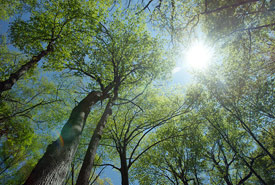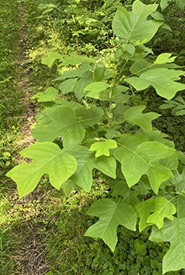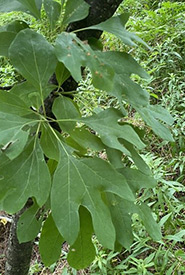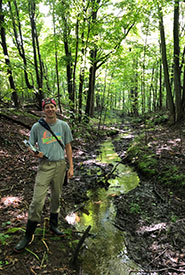Leaves like a familiar face

The breathtaking Backus Woods in Ontario. One of the best examples of Carolinian old-growth forest in the country. (Photo by Ann Tipper and Zach Melnick)
When you think of wild spaces filled with tall, deciduous hardwood trees tilting in warm winds, frost-free days late into the fall, an abundance of reptiles and amphibians shifting between swamps and marshes, and words like sassafras, Kentucky coffee tree and eastern prickly pear, what comes to mind? You wouldn’t be mistaken to picture something that resembles areas typically associated with the southern states or the Carolinas, but you likely wouldn’t think of southern Ontario as one of the best and only places in Canada to experience this type of habitat. This is because the region that these ecosystems occur in make up just a sliver of Canada’s vast landscapes.
The Carolinian Life Zone, making up only one per cent of Canada's total land area, is found only along the north shore of Lake Erie in southern Ontario. This region gets its name from the similar deciduous forests found in the eastern states like North Carolina and South Carolina. The thin strip of sandy soil and mild temperatures in the Carolinian Life Zone provide the most northern stronghold for large deciduous forests that are more common to the south. This region also happens to be where I have had the privilege to grow up, immersed in one of the most diverse ecosystems in Canada. Here, I played in the underbrush, swam in cold water creeks, and climbed towering trees that supported both my weight and my imagination. Two of these rooted companions have claimed a place in my mind and heart as some of my absolute favourites to encounter in the wild now that I spend extra time in places where they are quite common, such as Backus Woods in Norfolk County.
The two trees I am most happy to encounter on my travels are the tulip tree and sassafras tree. As someone who works and adventures in an area home to over 70 species of trees, it’s always nice to have some that are easy to identify with a quick glance at their foliage. Both of these tree species sport interesting leaves that stand out even among the dense canopy of forest skyline.

Tulip tree leaves (Photo by NCC)
The tulip tree leaf is seven to 12 centimetres long and straight across the top, with four lobes beneath. This may sound vague, however, when you look at them with the right childish eye — the leaves look very much like the silhouette of Sylvester the cat, a staple character in the Looney Tunes universe. In addition to its unique leaves that turn golden yellow in the fall, its yellow-green and orange flowers are a must-see attraction in this area, often visible from afar as the tulip tree can stand as tall as 35 metres when fully grown.
Although shorter and less vibrant than the tulip tree, my other favourite forest encounter plays to another human sense in a memorable way. The leaves of a sassafras tree, when bruised or scratched, give off a spicy or citrussy odour. Personally, I love the smell and find that it reminds me of Froot Loops cereal.
Enjoying both full shade and sunny environments, the versatile sassafras is able to establish itself in the forest understory and grow into a mature and healthy tree, where its seeds will begin to create colonies of sassafras in the surrounding area. This creates pockets of this extraordinary tree in moist to dry soil, commonly found in the Carolinian Life Zone close to the Lake Erie shore. Again, the leaves of the sassafras stand out among the many limbs stretching out for sunlight in our deciduous forests. They sport not one, but four possible leaf arrangements, sometimes occurring on the same branch!

Sassafras leaves (Photo by NCC)
Often described as mittens, a sassafras leaf can form a simple oval leaf, both a left- and right-handed mitten with a thumb-like lobe, and the last leaf form having three lobes similar to a rounded trident shape.
Being some of the less common tree species located in the Carolina zone, it is always a joy to come across them growing and thriving in the wild. These trees are found on many of the properties managed by the Nature Conservancy of Canada in Norfolk County, Ontario. I would encourage anyone who lives near or far from these biodiverse environments to come for a hike and keep their eyes peeled for a couple of special species that I have grown to love.


